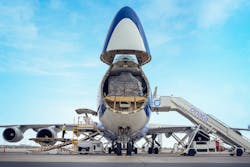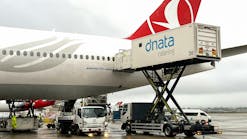Opportunities for the Cargo Handling Sector
Cargo volumes have helped keep ground handling alive in the midst of the pandemic. As the world emerges from the final stages of the pandemic, industry experts are assessing new trends in cargo handling – specifically special cargo, the handling of ‘preighter’ aircraft, opportunities for the cargo handling business and the industry’s continuing recovery.
Special Cargo
Special cargo is any cargo that is more challenging to handle and requires special procedures and/or treatment to accept, handle, load and carry. These special handling requirements can be due to the cargo’s nature, weight, dimensions or value, observes Burak Kurt, chief operations officer (COO) for cargo at National Aviation Services (NAS).
“Special cargo includes, but is not limited to, dangerous goods, perishables, live animals and valuables. In addition to these, in the past decade and especially over the past two years, pharmaceuticals have been in the spotlight. At NAS, we have all the systems and processes required to handle specialty cargo with teams that are well trained and up to speed,” he says.
The team members handling special cargo at each and every touch point must be equipped with the right knowledge to ensure the required conditions are fulfilled and, Kurt points out.
“Training is therefore key. The International Air Transport Association (IATA) is driving the industry standards to ensure standardization of these trainings, processes and procedures across the world and has detailed training for all types of special cargo,” he says. “When in search for a partner to handle special cargo, it is of utmost importance to find an organization which has the recommended certifications. For instance at NAS we hold the RA3, ISAGO and security clearance certifications.”
‘Preighter’ Aircraft and Cargo Loading
If one compares the ratio of freighters versus passenger aircraft, freighters are relatively rare within the fleet of recognized passenger airlines, observes Kurt.
“Generally, flag carriers have relatively smaller freighter fleets whereas privately owned, and most commonly low-cost carriers operate mostly only passenger aircraft,” he says. “In a similar way, looking at the world’s leading air cargo only operators, it can be observed that generally their feet sizes are small compared to passenger airlines. Considering that roughly 35 percent of the cargo transported around the world, by value, is carried by air, it is noteworthy to mention that roughly half of this cargo is carried in the belly of passenger flights.”
In response to the strong air cargo market demand for the rapid, reliable and efficient transportation of essential commodities, several airlines introduced additional cargo capacity during the pandemic by using passenger aircraft with seats fully or partially removed from the cabin, highlights Guillaume Crozier, senior vice president for UAE Cargo at dnata. These passenger aircraft converted for carrying additional freight have been referred to as “preighters.”
“To adapt to changing customer needs, we enhanced services, improved processes and trained more than 500 Dubai-based employees to safely and efficiently handle passenger planes carrying cargo only,” he says. “With no existing industry standards to refer to, we built the necessary procedures from scratch in collaboration with key stakeholders, including IATA and several airline customers. To ensure the procedures were safe, trials were conducted at Dubai International (DXB) using various loading and unloading methods across both narrow- and wide-body aircraft. This allowed us to identify the best and safest procedures to serve cargo-in-cabin flights,” says Crozier.
Loading of cargo onto freighters requires the same resources as passenger flights, together with some adjustments, according to Kurt.
“High loaders are required to be main deck as opposed to lower deck, ULD trolleys may need to be longer depending on the sizes used for the flight in question,” he says. “Special cargo may have specific requirements such as a crane for oversized cargo. Regardless of aircraft type, special arrangements are again required for valuable cargo, live animals and/or human remains.”
Aviation consultant Ivar Busk affirms that transforming passenger aircraft into cargo aircraft is also a booming business.
“The growing demand for cargo transport together with the extreme price increase has made it financially interesting to use those smaller cargo aircrafts. We now see many conversions of 15-20 years old aircraft, e.g., B757, B737, and A321,” he says. “If these are not modified with a cargo door, one can use normal high loaders and other loading devices. Otherwise there is the need for the same equipment as for ‘normal’ freighters.”
Opportunities Ahead
Kurt believes that there are opportunities for the development of the air cargo value chain at every level.
“Integration of technology into the value chain is one of the most predominant opportunities, to speed up the customer experience as well as reduce lead-times, ensure data integrity and facilitate inter-organization communications,” he says. “Furthermore, I see a lot of scope for the development of ‘smart warehouse equipment’ to assist in addressing the time-consuming processes within warehouses today.”
According to officials at dnata, digitalization and automation offer valuable opportunities for the cargo industry looking ahead.
“This year we will continue our digital transformation journey to provide the best possible services to our customers through advanced solutions. We will launch a next-generation e-commerce platform which will take CALOGI, our existing community platform, to a whole new level,” says Crozier. “It will allow stakeholders to conduct business with their customers and interact with authorities on one platform, sharing information and settling payments using their Calogi credit account.”
dnata’s customers will be able to integrate the platform into existing workflows through application programming interfaces (APIs) and take advantage of all innovative functions while using their own system, affirms Crozier.
“The platform will also help customers simplify existing processes, without investing in multiple systems. Furthermore, it will enhance sustainability by promoting paperless and cashless trade through collaboration and automation,” he says.
dnata is committed to digitizing its largest operation in the UAE by the beginning of 2023 by launching a its ‘OneCargo’ Terminal Operator Solution, adds Crozier.
“Artificial intelligence-driven tools and analytics provide enhanced visibility on sales and business performance, allowing customers to match real-time demand with available capacity for maximum profitability,” he says. “In addition, OneCargo eliminates all redundancies and manual check sheets, substantially improving operational efficiency.”
Ground Handling Business Recovery
As far as dnata is concerned, Crozier says that with constrained global cargo capacity due to pandemic related restrictions, shippers and freight forwarders have been increasingly opting to transport cargo through Dubai.
“There has been a massive growth in import general cargo volumes, including fashion accessories, electronics and fast moving consumer goods. Among the various categories of cargo, mail and courier have shown steady increases as compared to pre-pandemic volumes, indicating a rising trend with e-commerce shipments,” says Crozier. “Sea-air solutions are increasingly sought after at Dubai, given the city’s strengths as a logistics gateway to markets in the Middle East, Europe, Asia, Africa and beyond. Reflecting the strength of the markets for e-commerce and health products, we expect continued robust demand for our cargo services in 2022.”
Looking further ahead, Kurt believes that the ground handling industry is set for recovery.
“The medical impact of COVID-19 is reducing as time passes; the latest Omicron variant is indeed significantly more contagious, but it is having only minor physical impacts on the patients. Other variants are significantly less common; and hence, the global perception of risk appears to have reduced,” he says. “This is leading to both business and leisure travel to pick-up, resulting in flight numbers and load-factors picking-up. Naturally as flights take-off and land, the demand for ground handling will increase.”





